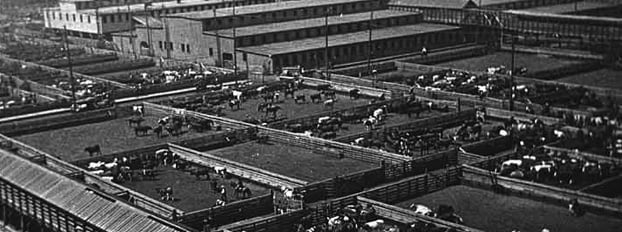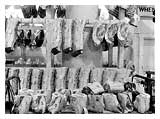
The Union Stockyards
Today, the idea of millions
of farm animals being transported hundreds of miles to a large city for
slaughter and processing seems bizarre. But for more than a century, that
is exactly what happened at the Union Stockyards in Chicago. For generations,
the Stockyards virtually defined Chicago, dubbed "Hog Butcher
to the World" by Carl Sandburg.
Established in 1865, "The Yards" processed two million animals yearly by
1870. By 1890 the number had risen to nine million. In 1921, the Stockyards
employed 40,000 people, and occupied more than a square mile of Chicago's
South Side from 39th to 47th and from Halsted to Ashland. Chicago had become
the meat-processing center of the world.
 The
impact on Chicago - and on labor history - was monumental. The Stockyards
story is teeming with strife: a bitter, ongoing struggle between labor
and management, and ethnic conflict among strikers and strikebreakers.
Labor negotiations at the Stockyards resulted in improvements in conditions
that would benefit the industry nationwide. It even had an impact on the
Chicago River: when the City reversed the flow of the Chicago River in
1900, it was largely to keep the Stockyards' enormous volume of waste products
from flowing into Lake Michigan. By mid-20th century, the industry began
to decentralize, and the Stockyards faded with little fanfare; the last
pen and killing floor were closed in 1971.
The
impact on Chicago - and on labor history - was monumental. The Stockyards
story is teeming with strife: a bitter, ongoing struggle between labor
and management, and ethnic conflict among strikers and strikebreakers.
Labor negotiations at the Stockyards resulted in improvements in conditions
that would benefit the industry nationwide. It even had an impact on the
Chicago River: when the City reversed the flow of the Chicago River in
1900, it was largely to keep the Stockyards' enormous volume of waste products
from flowing into Lake Michigan. By mid-20th century, the industry began
to decentralize, and the Stockyards faded with little fanfare; the last
pen and killing floor were closed in 1971.
Today the site is occupied by a flourishing industrial park.
The Stockyards
Memories of the Stockyards and Commentary by Dominic
Pacyga
Dominic Pacyga is a Columbia College professor who grew up in the back
of the yards in the 1950's and 1960's, and who worked at the stockyards
at the age of 20.
Memories of the Stockyards and the Labor Movement
by Les Orear
Les Orear, President of the Illinois Labor History Society, worked at the
stockyards beginning in 1932.
Behind the Scenes: What It Was Like to Film Around the Stockyards
By Tracy Ullman
It was unbelievable how much the original architecture of the Stockyards
had been dismantled and how in its place stood the modern buildings of
the Stockyards Industrial Park. To think that there were several "L" stops,
an entire set of tracks devoted solely to transporting thousands of tourists
and workers to the site daily--it had all been dismantled without a trace.
Many of the people we interviewed in the program were able to point out
where buildings had been, such as the prominent Armour and Swift factories
and the innumerable wooden pens for holding livestock, but it was hard
to imagine.
When cameraman Roy Alan and I went to shoot in Chiappetti's, the last veal
and lamb slaughterer in the city, it was the one remnant we could use to
qualify the smells, the look and the feel of the Union Stockyards. Very
few people driving by on Halsted around 39th Street would know that there
were hundreds of head of lamb and calves being held there--but once you're
inside, the smell is overpowering. Just north of Chiappetti's main offices
on Halsted is where the animals are slaughtered. Everyday, as part of a
kosher kill, a Rabbi stands at the front of a conveyor belt and slits the
throats of a seemingly endless supply of livestock. As the carcasses go
down the production line, they're cleaned and skinned and are prepared
to be broken down into edible cuts. When we went in to shoot on the kill
floor, both Roy and I feared getting hit by the fast-paced stream of carcasses
moving from one station to the next.
It was much the same in Lincoln Provisions, which is just around the corner.
They used to slaughter cattle, but now just break down the carcasses for
top quality cuts, such as filet mignon, that are then shipped around the
world. To be surrounded by so much dead flesh, many people asked us if
we wanted to go vegetarian. In fact, we never ate such good meat in our
lives and got a great feel why Chicago was and still is a meat capital
in the nation.
TRACY ULLMAN, producer of "The Union Stockyards" for Chicago Stories
began working on documentaries at the BBC. Her previous docs have been
on an eclectic variety of subjects, including British politics, Greek Rush
in the United States, and dating over the age of 50.
Links of Interest
"The
Jungle" by Upton Sinclair
Complete online text of the novel by Upton Sinclair (who'd worked in the
meat packing plants on assignment for a journalistic expose), detailing
illegal practices, unsafe food handling, and the squalor of the yards neighborhoods.
Review
of "The Yankee of the Yards"
Written by the Progressive Calvinism League, it details comparisons between
Upton Sinclair's account of the Stockyards and this biography of Gustavus
Franklin Swift, which gives the history of the meat packing industry from
the viewpoint of the son of the founder of the largest meat packing company
in the world.

Your $40 Gift Membership will include:
|
























































